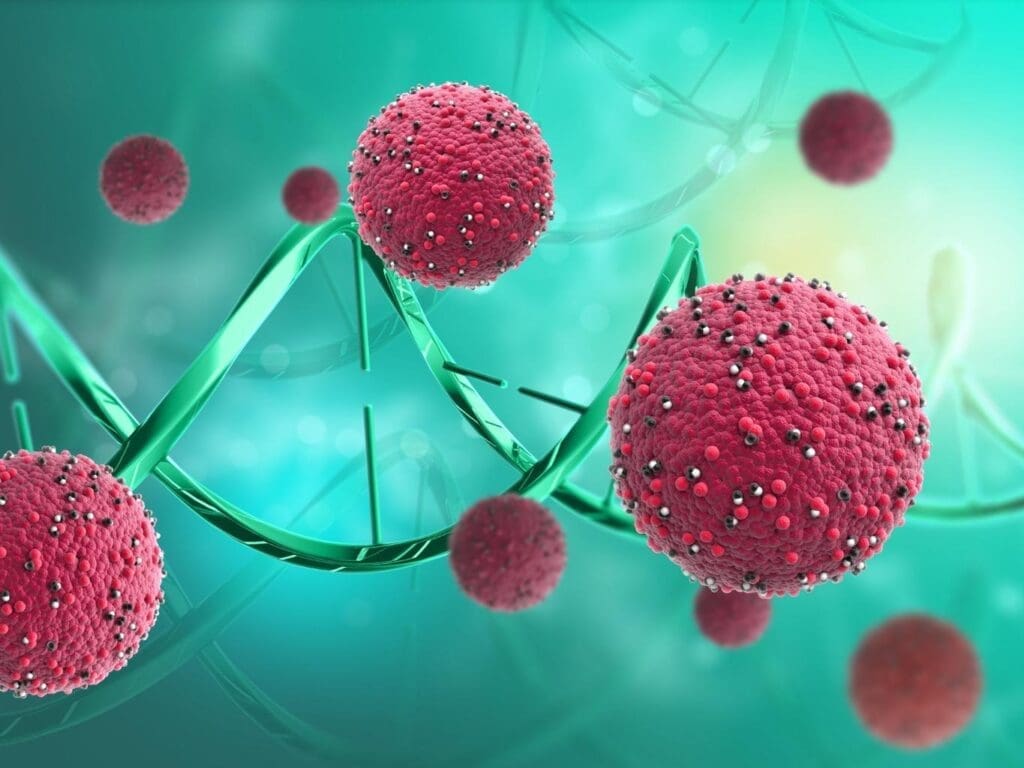Last Updated on November 26, 2025 by Bilal Hasdemir

Targeted therapy in cancer treatment is a big step towards precision medicine. It focuses on specific proteins that help cancer grow. This makes treatment more personalized and effective. You can learn more about it here: https://int.livhospital.com/what-is-immunotherapy/.
At Liv Hospital, we’re all about giving you the best in precision medicine and care. We use the latest in targeted cancer treatment. This way, we protect healthy cells and make treatment work better.
Key Takeaways
- Targeted therapy is a precision medicine approach that targets specific proteins involved in cancer growth.
- Liv Hospital provides high-quality patient care and innovative solutions for targeted cancer treatment.
- Targeted drugs interfere with molecular pathways critical to cancer cell proliferation and survival.
- Targeted therapy minimizes harm to healthy cells, maximizing treatment effectiveness.
- Precision medicine offers a more personalized and effective treatment option for cancer patients.
Understanding Targeted Therapy: A Precision Approach to Cancer Treatment

Targeted therapy has changed the fight against cancer, bringing more precise and effective treatments. We’re seeing a big change in how cancer is treated. Now, treatments are more personalized and precise.
The Evolution from Traditional Cancer Treatments
For years, chemotherapy and radiation were the main treatments for cancer. But they often harm healthy cells too, causing many side effects. Targeted therapies have changed this by focusing on specific cancer cells.
Research now focuses on finding specific genetic mutations to tailor treatments. This makes treatments more effective and with fewer side effects than old treatments.
Core Principles of Precision Medicine in Oncology
Precision medicine in oncology means treating each patient based on their unique cancer. It involves finding the genetic mutations in cancer cells and choosing treatments that target those mutations.
| Principle | Description | Benefit |
| Genetic Profiling | Identifying genetic mutations in cancer cells | Enables targeted treatment selection |
| Personalized Treatment | Tailoring treatment to individual genetic profiles | Improved treatment efficacy and reduced side effects |
| Monitoring and Adjustment | Continuous monitoring of treatment response and adjustment as needed | Enhanced patient outcomes through adaptive treatment strategies |
Understanding a patient’s cancer genetics helps choose the best targeted therapy. This leads to better treatment and outcomes for patients.
The Science of Protein Cancer Treatment: How Targeted Therapies Function

Targeted therapies are a new way to fight cancer. They work by interacting with specific proteins or genes that help cancer cells grow. This makes them more precise than old treatments.
Identifying Molecular Targets in Cancer Cells
First, doctors find out what makes a patient’s cancer unique. They use advanced tests to find the genes or proteins that make cancer grow. Then, they pick a therapy that blocks these growth signals.
In chronic myelogenous leukemia (CML), a special therapy targets the BCR-ABL protein. This protein is a result of a genetic mistake. Thanks to this therapy, CML patients are living longer and better.
Disrupting Cancer Cell Growth Pathways
These therapies block the signals that tell cancer cells to grow. They target tyrosine kinases, serine/threonine kinases, and other enzymes that cancer needs to survive.
| Pathway | Description | Targeted Therapy Example |
| Tyrosine Kinase Pathway | Involved in cell division and growth | Imatinib (Gleevec) |
| PI3K/AKT Pathway | Regulates cell survival | Idelalisib (Zydelig) |
| MAPK/ERK Pathway | Controls cell proliferation | Dabrafenib (Tafinlar) |
By focusing on these pathways, we can make treatments that work better and have fewer side effects. The goal is to find the best therapy for each patient based on their cancer’s unique traits.
Types of Targeted Cancer Therapeutics
Targeted cancer treatments have changed how we fight cancer. They aim at specific parts of cancer cells, leaving normal cells safe. This makes treatments more effective and less harmful.
Monoclonal Antibodies
Monoclonal antibodies are a key part of targeted therapy. They find and stick to proteins on cancer cells. Trastuzumab (Herceptin) targets HER2 in some breast cancers, slowing them down.
Rituximab (Rituxan) goes after CD20 on B cells, helping with some lymphomas. These antibodies can kill cells, block growth, or help the immune system attack.
Small Molecule Inhibitors
Small molecule inhibitors block molecules inside cancer cells. They are tiny and can get into cells to stop important proteins. This stops cancer cells from growing.
Imatinib (Gleevec) targets BCR-ABL in CML, stopping cells from growing. This has led to big improvements in CML treatment.
Immunotherapeutic Approaches
Immunotherapies use the immune system to fight cancer. They work by targeting parts of the immune system or cancer cells. This boosts the body’s fight against tumors.
Checkpoint inhibitors let the immune system attack cancer more easily. Pembrolizumab (Keytruda) and nivolumab (Opdivo) are examples. They have shown great promise in treating many cancers.
How Targeted Drugs Differ from Traditional Chemotherapy
Targeted drugs are different from traditional chemotherapy. They focus on cancer cells without harming healthy ones. This makes targeted therapies a better choice for many patients.
Specificity and Reduced Collateral Damage
Targeted drugs have a big advantage: they are specific to cancer cells. Traditional chemotherapy can hurt healthy cells too. Targeted therapies aim at specific cancer cell traits, reducing damage to healthy tissues.
They work in different ways, like monoclonal antibodies or small molecule inhibitors. These methods help target cancer cells without harming healthy ones. This makes treatment safer and more effective.
Side Effect Profiles Comparison
Targeted drugs and traditional chemotherapy have different side effects. Traditional chemotherapy can cause hair loss, nausea, and infections. This is because it affects all fast-growing cells, not just cancer ones.
Targeted therapies have fewer and milder side effects. While they can cause skin rashes or diarrhea, these are usually easier to handle. This makes treatment more tolerable for patients.
Using targeted drugs improves patient outcomes and quality of life. They help patients stay healthy and active. This is a big step forward in cancer treatment.
The Role of Genetic Testing in Targeted Cancer Therapy
Genetic testing is key in finding targeted cancer treatments. It looks at cancer cells’ genes to find specific mutations that cause tumors to grow. This helps doctors choose the best treatment for each patient.
Identifying Actionable Mutations
Genetic testing is great at finding actionable mutations. These are genetic changes that certain treatments can target. For example, some EGFR gene mutations in lung cancer can be treated with specific drugs.
“Genetic testing for actionable mutations is a big step forward in cancer care,” says a top oncologist. “It lets us tailor treatments to each patient’s cancer.”
Personalized Treatment Planning
Genetic testing helps plan treatments that fit each patient. It gives doctors detailed info on a patient’s cancer genes. This way, they can pick treatments that work best, cutting down on side effects and improving results.
The steps include:
- Collecting and analyzing tumor tissue or blood samples
- Identifying genetic mutations through advanced sequencing technologies
- Matching identified mutations with available targeted therapies
- Developing a personalized treatment plan based on genetic findings
By using genetic testing in cancer care, we can offer treatments that are more precise and effective. A reseacher says, “The future of cancer treatment is in tailoring therapies to each patient’s genetic profile.”
Success Stories: Breakthrough Targeted Therapies in Cancer Treatment
Targeted therapies have changed how we fight cancer. They’ve shown great promise in treating many cancers, making life better for patients. We’ll look at some big wins in cancer treatment, focusing on chronic myelogenous leukemia, HER2-positive breast cancer, and EGFR mutations in lung cancer.
Chronic Myelogenous Leukemia and Tyrosine Kinase Inhibitors
Chronic myelogenous leukemia (CML) has seen a big leap forward thanks to targeted therapy. Tyrosine kinase inhibitors (TKIs) have made a huge difference. Imatinib, the first TKI for CML, has greatly increased survival chances. Later TKIs like dasatinib and nilotinib have brought even better results, with fewer side effects.
TKIs have turned CML into a manageable disease for many. They work by blocking the BCR-ABL tyrosine kinase. This has brought many benefits, including:
- Improved overall survival rates
- Enhanced quality of life
- Reduced risk of disease progression
HER2-Positive Breast Cancer Treatments
Targeted therapies have also made a big difference in HER2-positive breast cancer. Trastuzumab (Herceptin) was a major breakthrough. Later, pertuzumab and ado-trastuzumab emtansine added more options.
These treatments have greatly helped patients with HER2-positive breast cancer. They work by targeting the HER2 protein, making chemotherapy more effective, and giving new hope to those with advanced disease.
EGFR Mutations in Lung Cancer
Targeted therapies have also changed the game for non-small cell lung cancer (NSCLC), focusing on EGFR mutations. Erlotinib and osimertinib are EGFR inhibitors that have shown great results in treating EGFR-mutant NSCLC.
Using EGFR inhibitors in NSCLC has led to:
- Improved response rates compared to traditional chemotherapy
- Prolonged progression-free survival
- Better overall survival in some cases
These stories show the power of targeted therapies in improving cancer treatment. As research keeps moving forward, we can look forward to even more breakthroughs in cancer treatment.
Challenges and Limitations of Targeted Cancer Treatments
Targeted therapies have changed cancer treatment a lot. But, they face challenges that impact how well they work. These treatments are precise but have their limits.
Resistance Mechanisms
One big challenge is when cancer cells develop resistance. Over time, they can stop responding to these treatments. This makes them less effective.
There are different ways cancer cells can resist. They might change the target gene, use other pathways, or alter their environment. It’s key to understand these to find ways to beat resistance.
Key Resistance Mechanisms:
- Secondary mutations in the target gene
- Activation of bypass signaling pathways
- Changes in the tumor microenvironment
Accessibility and Cost Considerations
Another big challenge is making these treatments available and affordable. They can be pricey, keeping many patients from getting them.
| Factor | Impact on Accessibility | Potential Solutions |
| High Cost | Reduces accessibility for many patients | Insurance coverage, patient assistance programs |
| Limited Availability | Geographic and institutional barriers | Telemedicine, expanded healthcare infrastructure |
| Complex Treatment Protocols | Requires specialized care and monitoring | Training for healthcare providers, patient education |
We need to tackle these challenges to fully benefit from targeted cancer treatments. We must make these therapies more accessible and affordable. Also, we should keep researching to find new ways to beat resistance.
Combination Approaches: Integrating Targeted Therapy with Other Treatments
Combining targeted therapy with other treatments has changed cancer care. Now, we can make treatment plans that fit each patient better. This makes treatments more effective and reduces side effects.
This method uses the best parts of different therapies. It creates a stronger treatment plan.
Synergistic Effects with Chemotherapy
When targeted therapy is mixed with chemotherapy, the results can be amazing. Targeted therapies can make chemotherapy work better by focusing on cancer’s growth drivers. For example, using a tyrosine kinase inhibitor with chemotherapy has helped in some cancers.
Clinical trials have shown this mix can lead to better results and longer survival. But, it’s important to watch out for side effects and how treatments interact.
Emerging Combination Strategies
Researchers are always finding new ways to mix treatments. Mixing targeted therapy with immunotherapy is very promising. It boosts the body’s immune fight against cancer.
Also, combining targeted therapy with agents that stop cancer growth is being studied. A recent study said, “The future of cancer treatment is in mixing different therapies well.”
“The development of resistance to targeted therapies can be mitigated by combining them with other treatments, improving patient outcomes.”
Studies show these mixes can lead to better, longer-lasting results. As research grows, we’ll see even more creative ways to treat cancer.
Patient Selection: Who Benefits Most from Targeted Cancer Therapies
Success in targeted cancer therapies depends on finding the right patients. Personalized medicine is key to unlocking these treatments’ full power. This means tailoring treatments to each patient’s needs.
Biomarker testing is vital in deciding who can get these treatments. Biomarkers are molecules in blood or tissues that show health issues or diseases.
Biomarker Testing and Eligibility
Biomarker testing helps find patients who will benefit most from targeted therapies. It looks at genetic mutations or protein expressions. This tells us if a patient’s cancer can be targeted.
| Biomarker | Therapeutic Target | Cancer Type |
| HER2 | HER2 protein | Breast Cancer |
| EGFR | EGFR mutation | Non-Small Cell Lung Cancer |
| BRAF V600E | BRAF mutation | Melanoma |
Knowing a patient’s cancer’s genetic makeup helps tailor treatments. This improves results and cuts down on side effects.
Predicting Treatment Response
Figuring out how a patient will react to a therapy is complex. It involves biomarker testing and understanding the tumor and patient’s health.
We use genetic sequencing, imaging, and tumor environment studies to predict responses. This helps create a treatment plan that works best for each patient.
In summary, choosing the right patients for targeted cancer therapies is essential. Biomarker testing and other tools help us find the best candidates. We then tailor treatments to meet their unique needs.
Advanced Cancer Care: Liv Hospital’s Approach to Targeted Therapy
At Liv Hospital, we’re dedicated to top-notch targeted therapy treatments. We use the latest in oncology. Our care is based on new protocols and advanced technologies, giving our patients the best treatment.
Innovative Protocols and Technologies
Liv Hospital leads in targeted therapy with new treatment plans. We use state-of-the-art genetic testing to find cancer cell mutations. This lets us create personalized treatment plans.
Our tools include:
- Advanced monoclonal antibodies
- Small molecule inhibitors for specific genetic mutations
- Immunotherapeutic methods that boost the immune system
These advanced tools help us target cancer cells better. This reduces harm to healthy tissues and boosts patient results.
Patient-Centered Care in Precision Oncology
At Liv Hospital, we see cancer treatment as caring for the whole person. Our focus on precision oncology means we consider every part of a patient’s care. We offer:
- Comprehensive support for international patients
- Personalized care plans for each patient’s needs
- Teams working together for complete care
Our dedication to patient care shows in our high satisfaction rates and treatment success.
Conclusion: The Transformative Impact of Targeted Therapy on Cancer Care
Targeted therapy is a big step forward in fighting cancer. It gives patients new hope and better treatment results. These therapies aim at specific parts of cancer cells, which means less damage to healthy cells. This makes patients’ lives better.
Targeted therapy has changed how we treat many cancers. It works for diseases like chronic myelogenous leukemia and HER2-positive breast cancer. Genetic tests and biomarkers help doctors tailor treatments to each patient. This ensures the best treatment for each person’s cancer.
The impact of targeted therapy on cancer care is huge. As research keeps getting better, we’ll see even more new treatments. At Liv Hospital, we’re dedicated to top-notch healthcare. We use the latest in targeted therapy to give our patients the best care.
FAQ
What is targeted therapy in cancer treatment?
Targeted therapy is a cancer treatment that uses drugs. These drugs target specific parts of cancer cells. This helps to stop cancer from growing without harming healthy cells.
How do targeted drugs work?
Targeted drugs block important pathways in cancer cells. This stops cancer from growing and spreading.
What is the difference between targeted therapy and traditional chemotherapy?
Targeted therapy is more precise, aiming only at cancer cells. It causes less damage to healthy cells. Traditional chemotherapy, on the other hand, can harm both cancer cells and healthy cells.
What is the role of genetic testing in targeted cancer therapy?
Genetic testing finds specific mutations in cancer cells. This helps doctors plan treatments that are most likely to work.
What are the different types of targeted cancer therapeutics?
There are several types of targeted cancer treatments. These include monoclonal antibodies, small molecule inhibitors, and immunotherapies. Each targets different ways cancer cells grow.
How does biomarker testing determine eligibility for targeted therapies?
Biomarker testing checks for specific genetic changes or proteins in cancer cells. This tells doctors if a targeted therapy will work for a patient.
What are the challenges associated with targeted cancer treatments?
Targeted treatments face challenges like resistance and high costs. These issues make it hard to find affordable and effective treatments.
Can targeted therapy be combined with other treatments?
Yes, targeted therapy can be used with other treatments. This combination can make treatments work better and improve results.
How does Liv Hospital approach targeted therapy?
Liv Hospital uses new methods and technology for targeted therapy. They focus on personalized care and support for international patients.
What is the significance of targeted therapy in precision medicine?
Targeted therapy is key in precision medicine. It allows for treatments that match a patient’s unique genetic and molecular details.
What are some success stories of targeted therapies in cancer treatment?
Targeted therapies have helped in many cancers. For example, they’ve improved treatments for chronic myelogenous leukemia, HER2-positive breast cancer, and lung cancer with EGFR mutations.
How does targeted therapy improve patient outcomes?
Targeted therapy leads to better treatment plans. This reduces side effects and improves life quality for patients.
References:
• Barrow Neurological Institute. (n.d.). Targeted therapy for cancer. https://www.barrowneuro.org/treatment/targeted-therapy/
• Wikipedia. (n.d.). Targeted therapy. https://en.wikipedia.org/wiki/Targeted_therapy
• National Cancer Institute. (n.d.). Targeted therapy. https://www.cancer.gov/about-cancer/treatment/types/targeted-therapies
• Nature. (2022). Molecular targeted therapy for anticancer treatment. https://www.nature.com/articles/s12276-022-00864-3
• National Center for Biotechnology Information. (2015). Limitations of targeted therapies. https://pmc.ncbi.nlm.nih.gov/articles/PMC4610026/






